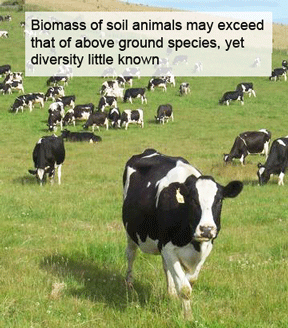Finding out what lies beneath
 What lives in soil? In August 2009 Pesq Agropec Bras (open access) an international cohort of 10 researchers from Canada, France, US, Taiwan, and Russia examine prospects for speeding assessment of soil animal diversity with COI DNA barcoding. As test sets, Rougerie and colleagues explore taxonomic and sequence diversity in earthworms and collembolans (springtails). These two groups comprise a similar number of named species (earthworms, 6000; springtails, 7900), but these totals likely underestimate true diversity, particularly for springtails, which are tiny (0.2 – 6.0 mm), challenging collecting and morphology.
What lives in soil? In August 2009 Pesq Agropec Bras (open access) an international cohort of 10 researchers from Canada, France, US, Taiwan, and Russia examine prospects for speeding assessment of soil animal diversity with COI DNA barcoding. As test sets, Rougerie and colleagues explore taxonomic and sequence diversity in earthworms and collembolans (springtails). These two groups comprise a similar number of named species (earthworms, 6000; springtails, 7900), but these totals likely underestimate true diversity, particularly for springtails, which are tiny (0.2 – 6.0 mm), challenging collecting and morphology.
For earthworms, the researchers analyzed COI sequences from 457 specimens collected in 13 countries around the world (including North America, South America, Caribbean, Europe, Middle East, Southeast Asia, and Australia); these represented at least 49 genera in 8 families. 87 species were identified by morphology, representing about 1/2 of specimens; the remainder, mostly those from Philippines and Brazil, could not be identified to species. Applying a threshold approach, the researchers found 192 (10% cutoff) and 211 (4% cutoff) genetic clusters, including two or more divergent clusters in 13 (15%) of named species. None of species showed sequence sharing or overlaps.
For springtails, 695 specimens from a similar global distribution of sites were analyzed, representing 88 genera in 16 familes; only 44 species were formally identified with morphologic characters, consistent with the “difficult and poorly known taxonomy of these organisms.” Of note, the authors report that “a specific protocol was developed for [collembolans] so that voucher specimens could be recollected after DNA extraction and thus be used for further morphological examination.” Sequence comparisons showed a “typical…bimodal distribution of intra- versus interspecific divergences such as the one also reported in earthworms.” Applying distance thresholds as above gave 215 (10% cutoff) and 227 (4% cutoff) genetic clusters. In conclusion, efficient assessment of soil animal diversity calls out for DNA barcoding.
On a separate note, soil animals may be useful for understanding mitochondrial evolution. Even factoring in species diversity, these animals appear to have enormous population sizes, given densities up to 4 x 103 earthworms/m2 and 1.8 x 106 collembolans/m3, yet show typical bimodal pattern of intra- << inter-specific variation noted above. Along these lines, in November 2009 Nature Nick Lane explores whys of mitochondrial evolution and speciation, including a possible “radically new picture of mitochondrial genes being tightly regulated by selection.” Stay tuned!
This entry was posted on Monday, December 14th, 2009 at 1:42 pm and is filed under General. You can follow any responses to this entry through the RSS 2.0 feed. Both comments and pings are currently closed.
December 15th, 2009 at 12:39 pm
Nematoda are still on the queue for being barcoded at such a world-wide scale. I would suggest to contact Steve Nadler (UCDavis) and Paul de Ley (UCRiverside) for important contributions in America, and Mark Blaxter (Edinburgh) for contributions in Europe.